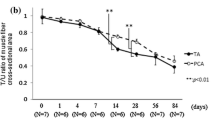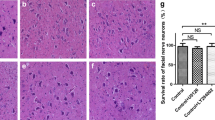Abstract
Testosterone propionate (TP) administered at the time of facial nerve injury in the hamster accelerates the rate of regeneration. In this study, we tested the hypothesis that the mechanism by which TP augments peripheral nerve regeneration involves regulation of glial fibrillary acidic protein (GFAP) mRNA in the facial motor nucleus. Castrated male hamsters were subjected to right facial nerve transection, with half the animals implanted subcutaneously with Silastic capsules containing exogenous TP and the remainder sham implanted. Postoperative survival times were 0.25, 1, 2, 4, 7, and 14 d. Qualitative/quantitative analyses of both film and emulsion autoradiograms were accomplished. Axotomy, with or without TP, resulted in a dramatic increase in GFAP mRNA levels by 1 d postoperative on the axotomized side, relative to controls. GFAP mRNA levels remained elevated throughout all postoperative times in both the nonhormone- and TP-treated animals. Qualitative examination of the film autoradiograms indicated a generalized decrease in the amount of GFAP mRNA in the control and axotomized nuclei of TP-treated animals when compared to the control and axotomized nuclei, respectively, of nonhormone-treated animals. Statistical comparison of the values obtained for both the film and emulsion autoradiograms confirmed this impression. Thus, while the injury-induced increases in GFAP mRNA expression were not blocked by TP, the overall extent of the increase was significantly tempered by steroid treatment. These data suggest that hormonal modulation of the astrocytic response to peripheral nerve injury may be a contributing factor in the ability of steroids to enhance the regenerative capacities of injured motor neurons.
Similar content being viewed by others
REFERENCES
Eng, L. F. 1988. Astrocytic response to injury. in Reier, P. J., Bunge, R. P., and Seil, F. J. (eds). Current Issues in Neural Regeneration Research. Alan R. Liss, New York.
Oblinger, M. M., Kost, S. A., and Singh, L. D. 1993. Regulation of type III intermediate filament protein genes in astrocytes during development and after injury. Pages 291–302 in Fedoroff, S., and Burkholder, G., (eds) Biology and Pathology of Astrocyte-Neuron Interactions. Plenum, New York.
Singh, L. D., and Oblinger, M. M. 1993. Reactive astrocytes in neonate brain upregulate intermediate filament gene expression in response to axonal injury. Int. J. Develop. Neurosci. 11:149–156.
Cammermeyer, J. 1955. Astrogial changes during retrograde atrophy of nucleus facialis in mice. J Comp. Neurol. 102:133–150.
Aldskogius, H. 1982. Glial cell responses in the adult rabbit dorsal motor vagal nucleus during axon reaction. J Neuropathol. Appl. Neurobiol. 8:341–349.
Graeber, M. V., and Kreutzberg, G. W. 1986. Astrocytes increase in glial acidic protein during retrograde changes of facial motor neurons. J. Neurol. 15:363–373.
LaVelle, A., and LaVelle, F. W. 1984. Neuronal reaction to injury during development. Pages 3–16. in Almki, C. R., and Finger, S. (eds). Developmental Neurobiology. Academic Press, New York.
Sar, M., and Stumpf, W. E. 1977. Androgen concentration in motor neurons of cranial nerves and spinal cord. Science 197:379–382.
Kujawa, K. A., Kinderman, N. B., and Jones, K. J. 1989. Testosterone-induced acceleration of recovery from facial paralysis following crush axotomy of the facial nerve in male hamsters. Exp. Neurol. 105:80–85.
Kujawa, K. A., Emeric, E., and Jones, K. J. 1991. Testosterone differentially regulates the regenerative properties of injured hamster facial motoneurons. J. Neurosci. 11:3898–3906.
Kinderman, N. B., and Jones, K. J. 1993. Testosterone enhancement of the nerve cell body response to injury: Evidence using in situ hybridization and ribosomal DNA probes. J. Neurosci. 13: 1523–1532.
Jones, K. J., and Oblinger, M. M. 1994. Androgenic regulation of tubulin gene expression in axotomized hamster facial motoneurons. J. Neurosci. 14:3620–3627.
Garcia-Estrada, J., Del Rio, J. A., Luquin, S., Soriano, E., and Garcia-Segura, L. M. 1993. Gonadal hormones down-regulate reactive gliosis and astrocyte proliferation after a penetrating brain injury. Brain Research. 628:271–278.
Jacob, S. K., Durica, T. E., and Jones, K. J. 1992. Testosterone effects on synaptic bouton changes after facial nerve injury in the hamster. Neurosci. Abs. 18:630.
Blinzinger, K., and Kreutzberg, G. 1968. Displacement of synaptic terminals from regeneration motoneurons by microglial cells. Zeitschrift für Zellforschung. 85:145–157.
Krey, L. C., and McGinnis, M. Y. 1990. Time courses of the appearance/disappearance of nuclear androgen + receptor complexes in the brain and adenohypophysis following testosterone administration/withdrawal to castrated male rats: Relationships with gonadotropin secretion. J. Steroid Biochem. 35:403–408.
Hawkins, R. A., and Mans, A. M. 1989. Determination of cerebral glucose use in rats using [14C] glucose. In: Neuromethods 11, Carbohydrates and Metabolism, pp. 195–230, Clifton, NJ, Humana.
Lewis, S. A., Balcarek, J. M., Krek, V., Sheanski, M., and Cowan, N. J. 1984. Sequence of cDNA clone encoding mouse glial fibrillary acidic protein: structural conservation of intermediate filaments. PNAS USA 81:2743–2746.
Kost-Mikucki, S. A., and Oblinger, M. M. 1991. Changes in glial fibrillary acidic protein mRNA expression after corticospinal axotomy in the adult hamster. J Neurosci. Research 28:182–191.
Oblinger, M. M., and Pickett, J. 1992. Rapid detection of neuronal mRNAs using 33P nucleotides for in situ hybridization. Du Pont Biotech Update 7:172–173.
Sokal, R. R., and Rohlf, F. J. 1981. F. J. Biometry: 2nd ed., San Francisco, Freeman.
Reier, P. J., Eng, L. F., and Jakeman, L. 1989. Reactive astrocytes and axonal outgrowth in the injured CNS: Is gliosis really an impediment to regeneration? in F. J. Seil (ed.), Neural regeneration and transplantation, Alan R. Liss, NY.
Tetzlaff, W., Graeber, M. B., Bisby, M. A., and Kreutzberg, G. W. 1988. Increased glial fibrillary acidic protein synthesis in astrocytes during retrograde reaction of the rat facial nucleus. Glia 1:90–95.
Jones, K. J., Harrington, C. A., Chikaraishi, D. M., and Pfaff, D. W. 1991. Estradiol regulation of ribosomal RNA processing in rat ventromedial hypothalamic neurons: Early detection by quantitative in situ hybridization. J. Neurosci. 10:1513–1521.
Kujawa, K. A., and Jones, K. J. 1995. Trophic actions of gonadal steroids on neuronal functioning normally and following injury. In: Advances in Neural Science (Malhotra, S., ed), Vol. 2, pp. 131–152. JAI Press Inc.
Kujawa, K. A., Tanzer, L., and Jones, K. J. 1995. Inhibition of the accelerative effects of testosterone on hamster facial nerve regeneration by the antiandrogen, flutamide. Exp. Neurol. in press.
Garcia-Segura, L. M., Suarez, I., Segovia, S., Tranque, P. A., Calés, J. M., Aguilera, P., Olmos, G., and Guillamón, A. 1988. The distribution of glial fibrillary acidic protein in the adult rat brain is influenced by the neonatal levels of sex steroids. Brain Research. 456:357–363.
Garcia-Segura, L. M., Torres-Aleman, I., and Naftolin, F. 1989. Astrocytic shape and glial fibrillary acidic protein immunoreactivity are modified by estradiol in primary rat hypothalamic cultures. Develop. Brain Res. 47:298–302.
Torres-Aleman, I., Rejas, M. T., Pons, S., and Garcia-Segura, L. M. 1992. Estradiol promotes cell shape changes and glial fibrillary acidic protein redistribution in hypothalamic astrocytes in vitro: A neuronal-mediated effect. Glia 6:180–187.
McQueen, J. K., Wright, A. K., Arbuthnott, G. W., and Fink, G. 1990. Glial fibrillary acidic protein (GFAP)-immunoreactive astrocytes are increased in the hypothalamus of androgen-insensitive testicular feminized (Tfm) mice. Neurosci. Letters. 118:77–81.
Nichols, N. R., Osterburg, H. H., Masters, J. N., Millar, S. L., and Finch, C. E. 1990. Messenger RNA for glial fibrillary acidic protein is decreased in rat brain following acute and chronic corticosterone treatment. Molec. Brain Research. 1:1–7.
O'Callaghan, J. P., Brinton, R. E., and McEwen, B. S. 1991. Glucocorticoids regulate the synthesis of glial fibrillary acidic protein intact and adrenalectomized rats but do not affect its expression following brain injury. Neurochem. 57:860–869.
Melcangi, R. C., Riva, M. A., Fumagalli, F., Magnaghi, V., Racagni, G., and Martini, L. 1996. Effect of progesterone, testosterone and their 5α-reduced metabolites on GFAP gene expression in type 1 astrocytes. Brain Research. 711:10–15.
Drengler, S. M., Handa, R. J., and Jones, K. J. 1996a. Sex differences in androgen receptor mRNA levels and regulation in hamster facial motoneurons. Molec. Brain Res. 35:131–138.
Drengler, S. M., Handa, R. J., and Jones, K. J. 1996b. Regulation of androgen receptor mRNA expression in hamster facial motoneurons: differential effects of nonaromatizable and aromatizable androgens. Molec. Brain Res. 35: in press.
Jung-Testas, I., Renoir, M., Bugnard, H., Greene, G. L., and Baulieu, E. E. 1992. Demonstration of steroid hormone receptors and steroid action in primary cultures of rat glial cells. J. Steroid. Biochem. Molec. Biol. 41:621–631.
Langub, M. C. Jr., and Watson, R. E. Jr. 1992. Estrogen receptor immunoreactive glia, endothelia, and ependyma in guinea pig preoptic area and median eminence: electron microscopy. Endocrinology. 130:364–372.
Santagati, S., Melcangi, R. C., Celotti, F., Maritini, L., and Maggi, A. 1994. Estrogen receptor is expressed in different types of glial cells in culture. J. Neurochem. 63:2058–2064.
Martini, L., and Melcangi, R. C. 1991. Androgen metabolism in the brain. J. Steroid Biochem. Molec. Biol. 39:819–828.
Tanzer, L., and Jones, K. J. 1996. Gonadal steroid regulation of hamster facial nerve regeneration: effects of dihydrotestosterone and estradiol. Exp. Neurol., submitted.
Svensson, M., Törnqvist, E., Aldskogius, H., and Cova, J. L. 1991. Synaptic detachment from hypoglossal neurons after different types of nerve injury in the cat. J. Hirnforsch. 32:547–552.
Svensson, M., and Aldskogius, H. 1993. Synaptic density of axotomized hypoglossal motoneurons following pharmacological blockade of the microglial cell proliferation. Exp. Neurol. 120: 123–131.
Chen, D. H., Chambers, W. W., and Liu, C. N. 1977. Synaptic displacement in intracentral neurons of Clarke's nucleus following axotomy in the cat. Exp. Neurol. 57:1026–1041.
Author information
Authors and Affiliations
Corresponding author
Rights and permissions
About this article
Cite this article
Jones, K.J., Kinderman, N.B. & Oblinger, M.M. Alterations in Glial Fibrillary Acidic Protein (GFAP) mRNA Levels in the Hamster Facial Motor Nucleus: Effects of Axotomy and Testosterone. Neurochem Res 22, 1359–1366 (1997). https://doi.org/10.1023/A:1022019106417
Issue Date:
DOI: https://doi.org/10.1023/A:1022019106417




